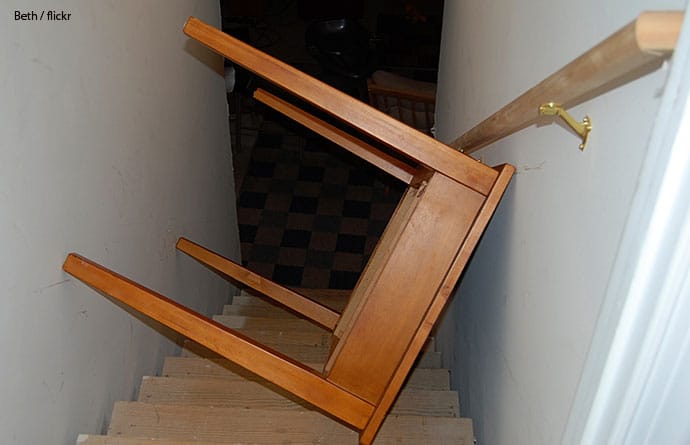
- How to Prepare For Moving Out of a Flat
- #1 Declutter
- #2 Measure Your Furniture
- #3 Moving Boxes Matter
- #4 Get Organised
- #5 Label your moving boxes
- #6 Dismantle as much as possible
- #7 Change Your Address
- #8 Reserve the Lift
- #9 Organise Parking
- #10 Know Exactly What You Are Taking With You
- #11 Decide How You Are Moving Home
- #12 Book Your Removal Company
- #13 Give Your Notice to Leave to the Landlord
- The Additional Costs of Moving From a Flat
- How to Book a Good Removal Company
- Tips for Moving Out of a Flat
Moving home is pretty much the same whether it is a house or a flat. Probably just more furniture and possessions in a house, right?
And moving out of a flat has to be a lot quicker and easier than a house, right?
You would have thought so, but moving from a flat is not that simple and can even be more expensive than moving out of a house.
But there are some things you can do to make it cheaper and easier.
In this week’s home moving blog, we look at the best way to move out of a flat, packing tips for moving out of a flat, additional costs to look out for, and how to find the best removal firm for moving out of a flat.
How to Prepare For Moving Out of a Flat

Moving out of a flat takes some extra planning, but with a little forethought, and good organisation, you will have a smooth relocation.
Here are our 13 top tips for preparing to move out of a flat.
#1 Declutter
Getting rid of all your unwanted items is crucial in any home move, but when moving out of an apartment it is even more essential.
Many removal firms will charge by the hour for smaller moves so you don’t want to waste time packing, and then have to pay to move things that you never use or don’t want.
The added bonus is that you may also make some money towards your moving costs by selling unwanted items.
Must read: How to Declutter for a Home Move – This epic guide takes you step by step through the process of decluttering every room in your home to make it easier and cheaper to pack and move.
#2 Measure Your Furniture
If you are moving out of a furnished rented flat then you are lucky in that you don’t have to pay to have those items moved.
Moving heavy and large pieces of furniture out of a flat can be expensive and very time-consuming. In some cases, windows have to be removed and hoists used to move such furniture.
All this extra work soon adds to your moving costs.
So measure any furniture you are taking carefully to see whether it will fit through the doorways and stairwells, as well as into the lift if there is one.
Make sure that the removal company you are hiring is fully aware of what pieces of furniture you intend to take.
If not, come moving day you will find your home move costs more, will take longer, and there may well not be enough space on the van to take everything.
Flatpack furniture is easy to get into a flat but when it comes to moving out there are usually problems.
Flat-pack furniture is not designed to be dismantled and reassembled, nor is it wise to try to move them assembled, in fact, some removal firms will refuse to do so.
Consider selling any furniture that is yours, it may be cheaper to sell and replace than move them.
You may like to know how to Make a Floor Plan – Useful tips on how to measure furniture and make a simple floor plan so that you can be sure your furniture fits in your new place.
#3 Moving Boxes Matter
For moving out of a flat it is best to use small to medium uniform-sized boxes.
There are a couple of reasons for this.
Firstly, if you have no lift, smaller boxes are easier to handle up and down stairs.
Secondly, if you do have a lift, boxes of uniform size will stack more easily and more efficiently.
Use only twin-walled boxes or consider using plastic tote boxes. This will keep your contents safe and will ensure the boxes stack safely.
Use only good quality packing tape, the extra handling the boxes will get moving out of a flat places additional stress on the moving boxes and tape.
Tape the carton edges and double-tape the boxes shut to keep the contents extra safe.
Save on moving boxes, save packing and unpacking time, and save space in the removal van by keeping clothes in drawers.
Most removal firms are happy to move full drawers of light clothing but check with your removal company first.
If you are only moving clothes and moving by car, then use strong plastic bags to pack your clothes in as sacks will fit into the car easier and make better use of the space.
You may like to read: How to Pack a Car for Moving Home in which we show you the easiest and best ways to pack a car for moving home.
#4 Get Organised
If you have limited space in your flat you are going to need to be super organised.
Clear a space so that the packed boxes can be stacked there, the nearer the front door the better (but ensuring the exit is clear in case of an emergency).
The balcony is also another good option for storing packed boxes if it is secure and weatherproof.
Some blocks of flats also have service rooms, the caretaker may let you store boxes there for a few days which you can do as you fill them without cluttering up your flat.
This will also make life a lot easier, and the move cheaper, on moving day.
#5 Label your moving boxes
This may seem a tedious job but it will make your move so much easier.
At the very least you should number the boxes and mark them so that you know which room they are for in your new home.
Also clearly mark if the contents are fragile and which way up the box should be carried.
Make a note on your phone what the box number is and what it contains.
When it comes to moving day the removal team can put the boxes straight into the right rooms.
And if you need to locate something before unpacking all the boxes you will know exactly which box the item is in.
Finally, if in the unlikely event a box went missing during the move, you would know what the contents of that box were for insurance purposes.
You may like to read: How to Label Moving Boxes: An Easy and Foolproof Way in which we explain a really simple method to identify your moving boxes which will make unloading and unpacking so much easier.
#6 Dismantle as much as possible
If you are moving furniture out of your flat then try to dismantle the pieces as much as possible so that they are easier to move.
Photograph the pieces as you dismantle them, then label them so that you know exactly how to reassemble the furniture.
Keep all the nuts and bolts in a bag securely closed and labeled so that you know what piece of furniture they belong to.
When dismantling electronics be sure to photograph all the connections, it will be so much easier when reconnecting them in your new home.
#7 Change Your Address
This is particularly important where the post is in communal areas, you don’t want to become a victim of identity theft or to miss out on special offers any company sends you.
We have created a change of address checklist for you that you can adapt to your own needs but it will give an excellent starting list.
#8 Reserve the Lift
If you are lucky enough to have a service lift then you should be able to reserve a time slot with the building manager to move your things.
If you have a communal lift then you may need to have a word with the other residents letting them know that you will be moving home using the lift.
Don’t forget that you will need to reserve the lift at your new property if you are moving into another flat.
#9 Organise Parking
Some blocks of flats have service areas and you may be fortunate enough to book a bay for the removal van to use.
If not, you need to either organise on-street parking or arrange for the removal lorry to get as close as possible to your block.
Some places will require parking permits or for the removal lorry to block a street, you will need to contact your local council to arrange this.
It is your responsibility to ensure there is parking available for your removal van so organise this as a priority.
Don’t forget to organise the parking at your new home too.
Note that the further away the removal van is from your flat, the further the removal team has to walk, then the more expensive your move is going to be.
#10 Know Exactly What You Are Taking With You
Decide exactly what you are taking to your new home, this will allow not only the removal firms that quote for your move to be as accurate as possible, but they can plan exactly what sized vehicle you need.
And if you are moving yourself you need to hire the most suitably sized vehicle, there is no point in hiring a van bigger than you need.
If at any stage you decide to take fewer or more items always let your removal company know, nobody likes surprises on moving day.
You may also like to know about hiring a self-drive van for your move – In this guide, we go through every aspect of hiring a van from the licence requirements to the size of van you need, to loading and safe driving.
#11 Decide How You Are Moving Home
If you are just moving a few boxes across town then you will probably choose to move home by yourself.
Moving just a few boxes yourself is not without risk and can be exhausting, so ensure you enlist the help of friends or family.
If you are moving furniture to your new home, or moving long-distance then it would, in most cases, be wise to hire a removal company.
When hiring a removal company be sure to do your research carefully.
Some removal firms won’t have hoists, some may not travel to the location you are moving to, some may not move small loads, and others may be fully booked for your move dates.
You may also like to read: How to Move Out of a Flat With No Lift. In this guide, we offer some useful tips for moving out of a flat that has no lift.
#12 Book Your Removal Company
Good removal firms are always in high demand especially during busy periods such as the summer, at the end of the month, and on a Friday.
Try to move home outside these peak times as your home move will be cheaper.
Book your removal firm as soon as you have a confirmed moving date, the more notice you can give the removal company the better.
#13 Give Your Notice to Leave to the Landlord
If you are moving out of a rented flat then be sure that you fulfill the terms of your contract with regards to ending your lease.
This will ensure that you get back your full security deposit and prevent any future problems.
Must read: How to Give Notice to Your Landlord at the End of Your Lease in which we go through how you should notify your landlord that you want to vacate the property and how to ensure that you get your full deposit back.







Share your thoughts by leaving a comment